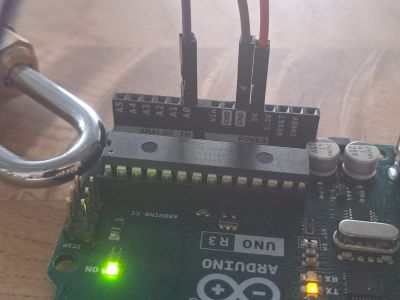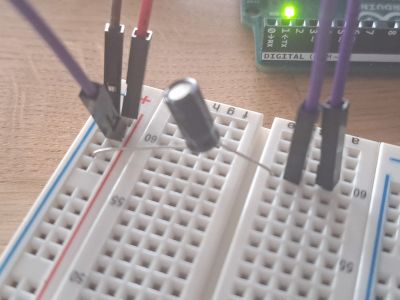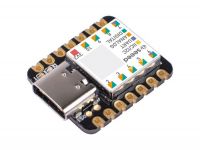Physical Controllers
Hand holding sensor
Measure the voltage - could be a chain of humans that hold hands, Arduino measure the voltage and smoothes it out with a capacitor. The LED is just to show the difference in voltage:
The Arduino connects to 5Volts, Ground and Analog 0
The Breadboard, purple wires are for holding in your hands. Capacitor to smooth out the voltage.
The code
void setup() {
// initialize serial communication at 9600 bits per second:
Serial.begin(9600);
pinMode(LED_BUILTIN, OUTPUT);
}
void loop() {
// read the input on analog pin 0:
int sensorValue = analogRead(A0);
// Convert the analog reading (which goes from 0 - 1023) to a voltage (0 - 5V):
float voltage = sensorValue * (5.0 / 1023.0);
// print out the value you read:
Serial.println(voltage);
digitalWrite(LED_BUILTIN, HIGH);
delay(voltage * 10);
digitalWrite(LED_BUILTIN, LOW);
delay(voltage * 10);
}
RFID Tag Reader
Can be used to read RFID Cards/ or write to them. Uses a ~3 Dollar RFID Reader (RC522) Worked best with Arduino Uno.
/*
* Initial Author: ryand1011 (https://github.com/ryand1011) * * Reads data written by a program such as "rfid_write_personal_data.ino" * * See: https://github.com/miguelbalboa/rfid/tree/master/examples/rfid_write_personal_data * * Uses MIFARE RFID card using RFID-RC522 reader * Uses MFRC522 - Library * ----------------------------------------------------------------------------------------- * MFRC522 Arduino Arduino Arduino Arduino Arduino * Reader/PCD Uno/101 Mega Nano v3 Leonardo/Micro Pro Micro * Signal Pin Pin Pin Pin Pin Pin * ----------------------------------------------------------------------------------------- * RST/Reset RST 9 5 D9 RESET/ICSP-5 RST * SPI SS SDA(SS) 10 53 D10 10 10 * SPI MOSI MOSI 11 / ICSP-4 51 D11 ICSP-4 16 * SPI MISO MISO 12 / ICSP-1 50 D12 ICSP-1 14 * SPI SCK SCK 13 / ICSP-3 52 D13 ICSP-3 15 * * More pin layouts for other boards can be found here: https://github.com/miguelbalboa/rfid#pin-layout
- /
- include <SPI.h>
- include <MFRC522.h>
- define RST_PIN 9 // Configurable, see typical pin layout above
- define SS_PIN 10 // Configurable, see typical pin layout above
- define LEDPIN 2
- define BUZZPIN 3
MFRC522 mfrc522(SS_PIN, RST_PIN); // Create MFRC522 instance
//*****************************************************************************************// void setup() {
Serial.begin(9600); // Initialize serial communications with the PC
SPI.begin(); // Init SPI bus
mfrc522.PCD_Init(); // Init MFRC522 card
Serial.println(F("Read personal data on a MIFARE PICC:")); //shows in serial that it is ready to read
pinMode(LEDPIN, OUTPUT);
pinMode(BUZZPIN, OUTPUT);
}
//*****************************************************************************************// void loop() {
// Prepare key - all keys are set to FFFFFFFFFFFFh at chip delivery from the factory. MFRC522::MIFARE_Key key; for (byte i = 0; i < 6; i++) key.keyByte[i] = 0xFF;
//some variables we need byte block; byte len; MFRC522::StatusCode status;
//-------------------------------------------
// Reset the loop if no new card present on the sensor/reader. This saves the entire process when idle.
if ( ! mfrc522.PICC_IsNewCardPresent()) {
return;
}
// Select one of the cards
if ( ! mfrc522.PICC_ReadCardSerial()) {
return;
}
Serial.println("CARD ID:");
digitalWrite(LEDPIN, HIGH);
//mfrc522.PICC_DumpDetailsToSerial(&(mfrc522.uid)); //dump some details about the card
for(int i=0; i < sizeof(mfrc522.uid.uidByte); i++){
Serial.print(mfrc522.uid.uidByte[i]);
tone(BUZZPIN, mfrc522.uid.uidByte[i]*60 + 100, 200);
digitalWrite(LEDPIN, LOW);
for(int j = 0; j < mfrc522.uid.uidByte[i]; j++){
if(j > 10)
continue;
digitalWrite(LEDPIN, HIGH);
delay(20);
digitalWrite(LEDPIN, LOW);
delay(20);
}
delay(300); }
Serial.println("\n");
delay(1000);
digitalWrite(LEDPIN, LOW);
//mfrc522.PICC_DumpToSerial(&(mfrc522.uid)); //uncomment this to see all blocks in hex
//-------------------------------------------
return;
Serial.print(F("Name: "));
byte buffer1[18];
block = 4; len = 18;
//------------------------------------------- GET FIRST NAME
status = mfrc522.PCD_Authenticate(MFRC522::PICC_CMD_MF_AUTH_KEY_A, 4, &key, &(mfrc522.uid)); //line 834 of MFRC522.cpp file
if (status != MFRC522::STATUS_OK) {
Serial.print(F("Authentication failed: "));
Serial.println(mfrc522.GetStatusCodeName(status));
return;
}
status = mfrc522.MIFARE_Read(block, buffer1, &len);
if (status != MFRC522::STATUS_OK) {
Serial.print(F("Reading failed: "));
Serial.println(mfrc522.GetStatusCodeName(status));
return;
}
//PRINT FIRST NAME
for (uint8_t i = 0; i < 16; i++)
{
if (buffer1[i] != 32)
{
Serial.write(buffer1[i]);
}
}
Serial.print(" ");
//---------------------------------------- GET LAST NAME
byte buffer2[18]; block = 1;
status = mfrc522.PCD_Authenticate(MFRC522::PICC_CMD_MF_AUTH_KEY_A, 1, &key, &(mfrc522.uid)); //line 834
if (status != MFRC522::STATUS_OK) {
Serial.print(F("Authentication failed: "));
Serial.println(mfrc522.GetStatusCodeName(status));
return;
}
status = mfrc522.MIFARE_Read(block, buffer2, &len);
if (status != MFRC522::STATUS_OK) {
Serial.print(F("Reading failed: "));
Serial.println(mfrc522.GetStatusCodeName(status));
return;
}
//PRINT LAST NAME
for (uint8_t i = 0; i < 16; i++) {
Serial.write(buffer2[i] );
}
//----------------------------------------
Serial.println(F("\n**End Reading**\n"));
delay(1000); //change value if you want to read cards faster
mfrc522.PICC_HaltA(); mfrc522.PCD_StopCrypto1();
}
SEEDUINO XIAO
A super small Arduino/Micropython device. About 15 Euros.
Connecting it to Arduino IDE: https://wiki.seeedstudio.com/Seeed_Arduino_Boards/


